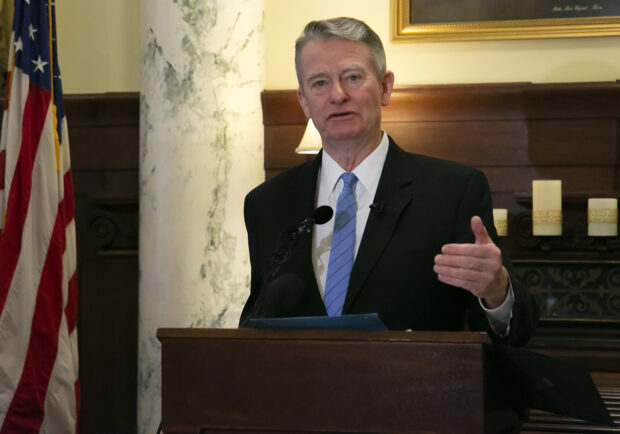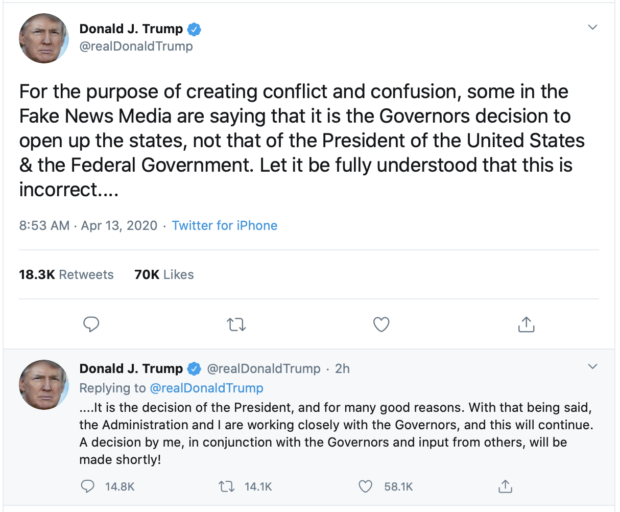
Gov. Brad Little announced he is extending Idaho’s statewide stay-home order through April 30 to help slow the spread of the novel coronavirus.
Speaking during a remote, virtual press conference Wednesday morning, Little said it’s important to extend the restrictions even though they have helped slow the spread already.
However, Little stressed there is no vaccine, no treatment to relieve symptoms and Idaho is far from achieving herd immunity to the virus.
“We can only imagine how many more cases and deaths we would have today if we hadn’t sacrificed together to slow the spread,” Little said. “We are truly seeing the flattening of the curve.”
The stay-home order does not address school closures or reopening, Little said. Instead, the State Board of Education, local administrators and Idaho public health officials will make school reopening decisions.
“Each school district has to craft a plan relative to the health conditions of their community and relative to what their students are,” Little said.
The State Board is set to address local school reopening criteria Thursday.
During Wednesday’s press conference, Little urged State Board members and local administrators to work with public health officials to make science-based decisions about schools.
“I would love to have all the kids go back to school tomorrow, but prudence dictates that I can’t do that,” Little said. “I still think allow the State Board, the department and school boards to work together to move academic advancement forward as best they can…. They’ll just have to address it on district-by-district basis.”
While the new stay-home order runs through April 30, Little said, restrictions may continue much longer.
“We may have to go through phases loosening and tightening of these measures until we have a vaccine or therapeutics or evidence of effective immunity building up,” Little said.
During Wednesday’s announcement, Little called on Idahoans to ramp up two practices: maintaining social distance and wearing face masks or coverings in public places.
Little announced the initial stay-home order March 25. It was set to expire at 11:59 p.m. today if Little hadn’t extended it.
“We will continue to fight coronavirus together and I appreciate your widespread support of your neighbors and communities,” Little said.
The politics of closing and reopening
A day earlier, during a telephone town hall meeting Tuesday, Little described his decision-making process.
“There is a lot of concern — as there should be — about where we are from both standpoints, from a safety and a prosperity standpoint, but I can’t have people be prosperous if they are not safe,” Little said. “That’s the decision that I get to wrestle with, but I don’t do it lightly.”
The process of reopening states looks different in different areas — and appears to have become somewhat of a political football.
For instance, House Speaker Scott Bedke and other Idaho Republican leaders have pressured Little to turn over control of the state’s coronavirus response to the state’s seven local health districts, Boise State Public Radio first reported. Bedke called the statewide stay-home order “ill-advised” and encouraged Little to let Idahoans govern themselves.
On Monday, President Trump tweeted, “For the purposes of creating conflict and confusion, some in the Fake News Media are saying that it is the Governors decision to open up the states, not that of the President of the United States & the federal Government. Let it be fully understood that this is incorrect…”

Trump has said he wants to reopen the country and the economy May 1.
Meanwhile, governors in clusters of neighboring states have formed coalitions to slow the spread and re-open their economies.
Governors of California, Oregon and Washington have formed such a coalition. But the Spokane, Wash., Spokesman-Review reports Washington Gov. Jay Inslee has not yet coordinated with Little.
“I understand he’s having some controversy with his plans in Idaho, so we have that issue that he’s got to work through,” the Spokesman-Review quoted Inslee as saying.
Little said he plans to speak with Oregon Gov. Kate Brown in the next couple of days.
“I am always interested in cooperating with other states so collectively we can address this issue, but there is quite a bit of difference between Idaho and those other three states,” Little said. “I have no problem cooperating on data, cooperating on research, cooperating on supplies but we are pretty different than those other states.”
U.S. Rep. Mike Simpson, R-Idaho, praised both Little and Trump’s leadership.
“Both are working with health care experts to ensure Idahoans are safe and have necessary resources,” Simpson tweeted Wednesday afternoon. “We all have the same goal in mind, let’s get the economy working again all while keeping the public healthy and safe.”
For the record, Little said extending the stay-home order through April 30 is in compliance with guidance issued by the Centers for Disease Control and Prevention and The White House.
Large portions of Little’s press conference were geared towards businesses and reopening the economy. Under the extended stay-home order, Little will allow some previously nonessential businesses to reopen for delivery or curbside pickup. Specific examples he listed included floral shops, garden centers and jewelry stores.
“I also want Idahoans to know that I deeply care about economic prosperity, getting back to work and our children getting back to school,” Little said. “More than anything, I want Idaho to know how much confidence I have in our people being part of the solution to this global pandemic.”
Confirmed cases update
At its 5 p.m. updated Wednesday, the state reported 1,587 COVID-19 cases and 41 deaths across Idaho. That’s an increase of 49 new cases and two deaths since Tuesday afternoon.
New this week, the state is now including confirmed and probable cases in the statewide totals. Prior to this week, the state was posting confirmed cases.
There are cases in 32 of Idaho’s 44 counties.
Counties with the most cases include Ada (541), Blaine (463), Canyon (179), Twin Falls (87) and Kootenai (48).
Check back with Idaho Education News Thursday afternoon for full coverage of the State Board of Education’s meeting on setting criteria for reopening schools.
